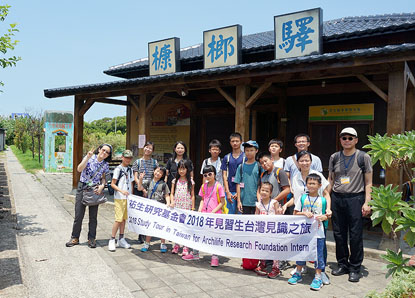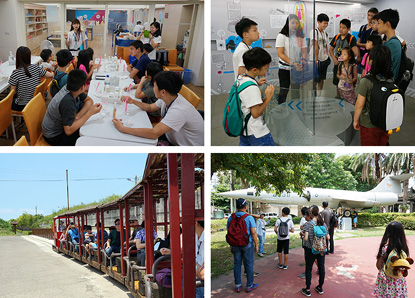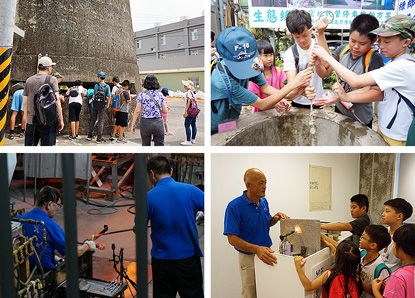Sketch of Archilife Study Tour, August 2018Date: 2018-09-18
Section: Activity |  8月份見識之旅活動,2018年8月18日由呂明澐小姐帶領16位祐生見習生及家長們,進行新竹槺榔戰後遺跡回顧暨綠能玻璃探索之旅。活動開始之初,領隊呂明澐小姐提醒本次活動注意事項及觀察重點,先行建立見習生的背景知識。 8月份見識之旅活動,2018年8月18日由呂明澐小姐帶領16位祐生見習生及家長們,進行新竹槺榔戰後遺跡回顧暨綠能玻璃探索之旅。活動開始之初,領隊呂明澐小姐提醒本次活動注意事項及觀察重點,先行建立見習生的背景知識。
For the study tour of August 18, 2018, Ms. Lu Ming-yun led 16 ARF interns and their parents on a tour to discover eco glass and visit postwar relics in Kanglang, Hsinchu. At the start of the day's activities, team leader Ms. Lu Ming-yun reminded everyone about things to note and what to observe, and gave the interns some background knowledge.
 本次上午行程,第一站參訪濟生觀光工廠。導覽人員以人體器官構造為主軸,針對消化系統運作,解釋食物被吃進肚子後,會經過哪些器官並如何轉換成養分。隨後以互動螢幕,讓眾人檢視自身辨色程度,初步了解眼睛是否有黃斑部病變的可能。緊接著,導覽人員配合一旁圖說,講述器官一日的運行,說明如何調配日常活動與飲食對身體最佳。離開濟生觀光工廠後,前往康樂社區,由在地居民擔任導覽人員。早期此地因茂生槺榔樹而得名,故舊時稱「槺榔庄」,又處貿易物資運輸線上而有輕便車道經過。見習生首先搭乘輕便車進行社區巡禮,導覽人員沿途介紹社區祖先渡海來台開墾的歷史,以及輕便車的由來及修復過程,為眾人對該社區發展歷程建立印象。 本次上午行程,第一站參訪濟生觀光工廠。導覽人員以人體器官構造為主軸,針對消化系統運作,解釋食物被吃進肚子後,會經過哪些器官並如何轉換成養分。隨後以互動螢幕,讓眾人檢視自身辨色程度,初步了解眼睛是否有黃斑部病變的可能。緊接著,導覽人員配合一旁圖說,講述器官一日的運行,說明如何調配日常活動與飲食對身體最佳。離開濟生觀光工廠後,前往康樂社區,由在地居民擔任導覽人員。早期此地因茂生槺榔樹而得名,故舊時稱「槺榔庄」,又處貿易物資運輸線上而有輕便車道經過。見習生首先搭乘輕便車進行社區巡禮,導覽人員沿途介紹社區祖先渡海來台開墾的歷史,以及輕便車的由來及修復過程,為眾人對該社區發展歷程建立印象。
The first stop in the morning was Chi Sheng tour factory. Focusing on the human anatomy and the digestive system, the tour guide explained how food is digested and converted into nutrients by the various organs. Using an interactive screen, everyone also checked out their own color recognition ability and found out if they are at risk of macular degeneration. Next, with the drawings, the tour guide described the daily functioning of the human organs, and explained how to best combine daily activities and diet for the body. Leaving the tour factory, everyone made their way to Kangle community, and the tour was guided by the local resident. In the early days, it was called "Kanglang Village" due to the Kanglang trees (Phoenix loureiroi) flourishing in the area. It also has a pushcart train for transporting trade goods in the past. The interns toured the community in the handcar while the tour guide described the history of how the community's pioneers traveled across the sea to claim the land, and the origin and rebuilding of the railway of the handcar, leaving an impression on everyone.
 中午飯後,進行社區導覽。導覽人員指出二戰時期,日本軍方在此建造碉堡,而成為美軍掃射目標,至今仍保留牆面彈孔痕跡。接著移動到水井區,是早期生活用水來源,迄今仍能取用,導覽人員教導打水技巧,眾人躍躍欲試。行程最後,前往春池綠能玻璃觀光工廠,由吳廠長擔任導覽老師。廠長首先講述新竹發展玻璃產業的優勢,隨後說明該廠以回收廢玻璃起家,目前以獨家技術將廢玻璃再製成工藝品或建材,亦比較玻璃碎片經磨碎熔燒等加工前後的差異。接著進入實做區,透過觀察老師傅們實際創作過程,認識玻璃工藝品大致的吹製流程。隨即至簡報室觀看影片,內容講述該廠發展歷程與廢玻璃回收再製的例子。影片播畢後,廠長介紹影片中提及的專利產品-防火磚,實地測試防火隔音之效,請見習生上前觸摸,眾人皆對其防火隔熱效果驚嘆不已。至此,本日活動已近尾聲,大家一起合照留念後搭車返程,並期待於下次見識之旅再相見。 中午飯後,進行社區導覽。導覽人員指出二戰時期,日本軍方在此建造碉堡,而成為美軍掃射目標,至今仍保留牆面彈孔痕跡。接著移動到水井區,是早期生活用水來源,迄今仍能取用,導覽人員教導打水技巧,眾人躍躍欲試。行程最後,前往春池綠能玻璃觀光工廠,由吳廠長擔任導覽老師。廠長首先講述新竹發展玻璃產業的優勢,隨後說明該廠以回收廢玻璃起家,目前以獨家技術將廢玻璃再製成工藝品或建材,亦比較玻璃碎片經磨碎熔燒等加工前後的差異。接著進入實做區,透過觀察老師傅們實際創作過程,認識玻璃工藝品大致的吹製流程。隨即至簡報室觀看影片,內容講述該廠發展歷程與廢玻璃回收再製的例子。影片播畢後,廠長介紹影片中提及的專利產品-防火磚,實地測試防火隔音之效,請見習生上前觸摸,眾人皆對其防火隔熱效果驚嘆不已。至此,本日活動已近尾聲,大家一起合照留念後搭車返程,並期待於下次見識之旅再相見。
After lunch, during the tour of the community, the tour guide pointed out that the community became a shooting target for the US army during the Second World War as the Japanese army had built pillboxes there, leaving traces of the bullet holes on the walls till the present day. Next, everyone proceeded to the water well area, which was the source of domestic water supply in the early days. Still usable today, the tour guide taught everyone how to fetch water and the interns were eager to try. The end of the tour brought everyone to Spring Pool Glass Tourism Factory. Factory manager Mr. Wu, who acted as the tour guide, talked about Hsinchu's advantage in the development of the glass industry. He then explained that the factory had begun as a glass recycling factory, and it now uses its proprietary technology to turn recycled glass into artworks and building materials. He also showed the differences in the broken glass after it has been processed by grinding, melting, etc. In the workshop area, the interns had a general understanding of glass blowing by watching old master craftsmen at work. They then watched a video in a briefing room which described the history of the factory and examples of glass recycling and re-making. At the end of the video, the factory manager introduced their patented product-refractory brick, which was mentioned in the video. He even tested its fire resistance and sound proofing effects on site, and invited the interns to touch the brick. Everyone was amazed by its fire resistance and heat insulating effects. At this point, the day's itinerary came to an end. Everyone took a group photo before heading back and looked forward to the next study tour.
|
|